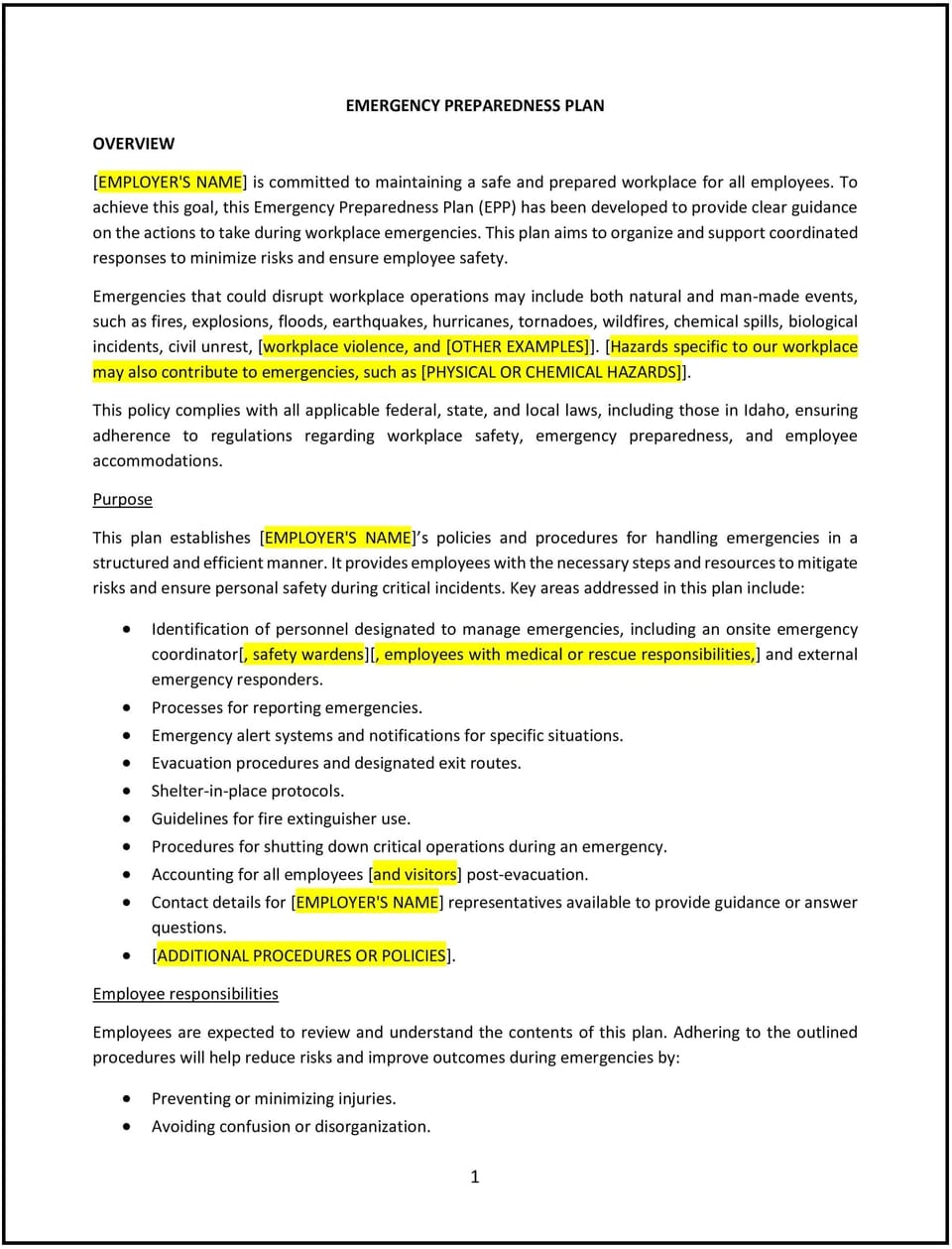Emergency preparedness plan (Idaho): Free template

Emergency preparedness plan (Idaho)
An emergency preparedness plan helps Idaho businesses establish procedures for responding to emergencies such as natural disasters, fires, medical incidents, or security threats. This plan outlines the steps for evacuation, communication, and recovery to ensure the safety of employees, customers, and property. It reflects the business’s commitment to protecting lives and minimizing disruptions during emergencies.
By implementing this plan, businesses can enhance safety, reduce risks, and maintain operational continuity in the face of unexpected events.
How to use this emergency preparedness plan (Idaho)
- Identify potential emergencies: Assess the types of emergencies most likely to occur in Idaho, such as earthquakes, wildfires, floods, or severe weather.
- Develop response procedures: Outline specific steps for responding to each type of emergency, including evacuation routes, shelter-in-place protocols, and emergency contacts.
- Assign roles and responsibilities: Designate employees to lead emergency response efforts, such as evacuation coordinators, first aid responders, and communication liaisons.
- Establish communication plans: Provide guidelines for communicating with employees, customers, and emergency services during an emergency, including backup communication methods.
- Prepare emergency supplies: Maintain essential supplies, such as first aid kits, flashlights, batteries, and water, in accessible locations.
- Conduct training and drills: Train employees on the emergency preparedness plan and conduct regular drills to ensure readiness.
- Review and update: Regularly review the plan to ensure it remains aligned with business operations, employee needs, and Idaho-specific risks.
Benefits of using this emergency preparedness plan (Idaho)
This plan provides numerous benefits for Idaho businesses:
- Enhances safety: A well-prepared plan helps protect employees, customers, and property during emergencies.
- Reduces risks: By identifying potential hazards and outlining response procedures, businesses can minimize the impact of emergencies.
- Maintains operational continuity: The plan helps businesses recover quickly and resume operations after an emergency.
- Builds confidence: Employees and customers feel more secure knowing the business is prepared for emergencies.
- Supports compliance: The plan aligns with best practices for workplace safety and emergency preparedness.
- Encourages accountability: Designated roles and responsibilities ensure a coordinated and effective response to emergencies.
- Improves resilience: Regular training and drills help employees respond effectively, reducing panic and confusion during emergencies.
Tips for using this emergency preparedness plan (Idaho)
- Communicate the plan effectively: Share the plan with employees during onboarding, training sessions, and through internal communications to ensure awareness.
- Train employees: Provide training on emergency response procedures, evacuation routes, and the use of emergency supplies.
- Conduct regular drills: Schedule drills for different types of emergencies to test the plan and identify areas for improvement.
- Update contact information: Maintain up-to-date contact lists for employees, emergency services, and key stakeholders.
- Inspect emergency supplies: Regularly check and replenish emergency supplies to ensure they are ready for use.
- Review the plan regularly: Update the plan as needed to reflect changes in business operations, employee needs, or Idaho-specific risks.
- Lead by example: Encourage leadership to participate in training and drills, demonstrating a commitment to emergency preparedness.
Q: Why should Idaho businesses have an emergency preparedness plan?
A: An emergency preparedness plan helps businesses protect employees, customers, and property during emergencies, reduce risks, and maintain operational continuity.
Q: What types of emergencies should businesses plan for?
A: Businesses should plan for emergencies such as natural disasters, fires, medical incidents, or security threats, based on Idaho-specific risks.
Q: How should businesses develop response procedures?
A: Businesses should outline specific steps for responding to each type of emergency, including evacuation routes, shelter-in-place protocols, and emergency contacts.
Q: Who should be involved in emergency response efforts?
A: Businesses should designate employees to lead emergency response efforts, such as evacuation coordinators, first aid responders, and communication liaisons.
Q: How should businesses communicate during an emergency?
A: Businesses should establish communication plans, including backup methods, to contact employees, customers, and emergency services during an emergency.
Q: What supplies should businesses have on hand for emergencies?
A: Businesses should maintain essential supplies, such as first aid kits, flashlights, batteries, and water, in accessible locations.
Q: How often should the plan be reviewed?
A: The plan should be reviewed annually or as needed to reflect changes in business operations, employee needs, or Idaho-specific risks.
This article contains general legal information and does not contain legal advice. Cobrief is not a law firm or a substitute for an attorney or law firm. The law is complex and changes often. For legal advice, please ask a lawyer.


